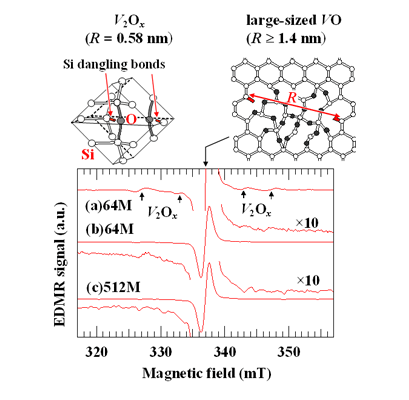ESR (Electron Spin Resonance) Spectroscopy Laboratory Takahide Umeda’s laboratory | University of Tsukuba, Institute of Applied Physics
ESR for micro-devices (EDMR)
EDMR (Electrically Detected Magnetic Resonance) spectroscopy makes it possible to observe ESR signals of defects and impurities in micro-devices via device currents. Even nanometer-sized devices are available for EDMR measurements. We have a lot of experiences for applying this technique to various micro-devices. For example, we have revealed the key defects in silicon memories (dynamic RAM), that control the data retention time of dynamic RAMs (see Figs. 4 and 5 in this page). Kindly find other examples in our publication list.
 |
| Fig. 4. EDMR founds the VO defects in Si micro-devices |
| VO defects are a series of silicon vacancy-oxygen complex defects. EDMR has revealed their presence in the heart of Si micro-transistors in Si LSIs. These defects can affect strongly on the performance of Si micro-transistors, e.g., the data retention time in DRAM devices. See details in T. Umeda et al., J. Appl. Phys. 94, 7106-7111 (2003). |
 |
| Fig. 5. A single defect determines the performance of Si micro-devices |
| This example shows VRT (Variable Retention Time) phenomenon observed in DRAM devices. This serious change in the data retention times of DRAM’s memory cells originates from a single VO defect inside a silicon transistor. See details in T. Umeda et al., Appl. Phys. Lett. 88, 253504 (2006). |
 |
| Fig. 6. EDMR study on SiC-MOS interface defects |
| The SiC-SiO2 interface defects (MOS interface defects) are one of the most critical issues for SiC device technology. Their origins are not yet clear. Our low-temperature EDMR measurements on 4H-SiC MOSFETs have successfully revealed interfacial carbon dangling-bond defects. They play a critical role and are sensitive to oxidation, hydrogenation, and nitridation processes. (presented at T. Umeda et al., ECSCRM 2010, Oslo ,Norway, Aug. 30 - Sep. 4, 2010). |
[Page top]